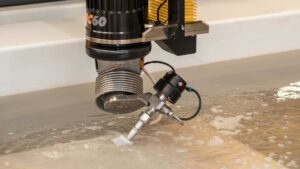More and more people are opting for waterjet cutting for mechanical cutting projects, be it fabricators, professionals, or amateur hobbyists. However, when considering waterjet cutting process, the waterjet cutting cost per hour basis is something to evaluate.
In this article, you will learn all about the various parts of waterjet cutting costs. Keep reading to find out how much your next project is going to cost:
Is waterjet cutting expensive?
When you factor in all the applications of waterjet cutting, you will find that the overall cost of water jet cutting prices is one of the cheapest in the market.
If you base your decision purely on a per-hourly rate, waterjet cutting machines can feel to be a more expensive option than other cutting alternatives. However, you are forgetting about the major factors that make waterjet cutting the best cutting process.
For instance, unlike other cutting processes, waterjet cutting is a cold cutting process and doesn’t harm the material quality since there is an absence of high heat.
Additionally, you can create multiple cuts in different layers of bulk materials by placing one layer on top of the other (called stacking). Stacking isn’t really possible in other cutting techniques.
What are the factors that influence the operating costs of waterjet cutting?
There are various factors that influence the overall cost of abrasive waterjet cutting. These factors are:
- Water Consumption: Water is a very minor factor when we discuss the cost of water jet cutting machines. For one thing, most of the water used in the waterjet cutting technology is recycled. Taking national average, cost of water is about $3 for a 1000 gallons. Therefore, you can even disregard the cost of water while calculate cutting costs.
- Electricity Consumption: Unlike water consumption, the cost of electricity is a major factor that adds to waterjet cutting cost per hour. The exact cost of electricity will vary based on the machine you use and the cost per KW in your area. It can range anywhere from $3000 to $9000 per year if your machine runs 6 hours a day (2000-2100 hr/year).
- Wear of Parts: It is no surprise that when you are using waterjet cutting, machine parts like nozzles and pump seals are going to wear out regularly. Therefore, you need to account for the cost of these parts as well. Here is a list of parts that commonly wear out in waterjet cutters, along with the cost and lifespan of each:

- Cost of Abrasive: This part makes up the major portion of abrasive waterjet cutting cost per hour basis. Usually, garnet abrasive is added to waterjet cutting, which costs about 25 cents per pound of abrasive. This cost can vary a little based on the type and quality of abrasive you use. For instance, high quality garnet can be expensive compared to uneven hard rock abrasive.
- Quality and Type of Waterjet cutters: As is obvious, different abrasive waterjet cutters perform differently. A high-end waterjet cutter can take up a high initial investment but might save you some money on the running costs. Additionally, pure-waterjet cutting costs significantly less than abrasive waterjet cutting cost, but it only works for soft materials like rubber and foam.
- Cutting Time: The longer time you spend on cutting a material, the more resources the cutter will use which will amp up the costs of cutting.
- Garnet Flow Rate: Garnet flow rate (or abrasive flow rate) is important to consider when calculating costs of a waterjet cutting system. For instance, metal plate cutting requires about 1 to 2 pounds of typical garnet abrasive per minute, which leads to a cost between $18 to $36 per hour on abrasive alone.
- Programming and Data Input: Efficient programming and data input makes sure that the cuts take place in the most effective manner. There is no time and resources wasted on unnecessary processes, leading to reduced costs.
What are the hourly costs to run an abrasive waterjet?
As we saw in the last section, the costs of waterjet cutting can vary significantly based on the different factors we mentioned. Most of these factors, in turn, depend on the material you intend to cut. Softer materials will go easy on costs due to cutting time and abrasives.
The quality of cuts you require will also affect the cost that will incur. For high quality cuts, you need to take the waterjet cutting process a little slower, which will lead to higher hourly cost. If high quality cuts aren’t a requirement, you can increase the cutting speed and save on the waterjet cutting cost.
Typically, waterjet cutting cost per hourly rate lies somewhere between $12 to $30 per hour. Of course, in specific requirements, this number can go higher or lower.
Here is an example of hourly cost breakup of waterjet machine in different situations:

How Much Does a Water Jet Cutter Cost?
So far we have gone through the cost of the waterjet cutter on hourly basis. However, you might’ve forgotten tiemabout one very important cost- the cost of the waterjet cutter itself. This important cost can be a significant one-time investment and something you should factor into your budget decisions.
For starters, you can find small waterjet machines at a price point of $60,000. However, those might not give you the best value for money in the long run. If you want to make the most out of your investment, we recommend going with the Techniwaterjet G2 CNC waterjet cutters which starts at $100,000.
If budget isn’t a restriction, you can check out high-end models in the Techniwaterjet series that can range up to $450,000.
How to Calculate Waterjet Costs for a Project?
When you are calculating waterjet costs for a project, you should take into account the following four things:
Material Types:
There are different types of materials out there. When you buy a waterjet machine, you will get information on how much time it will take to cut through per inch of any particular material. You can evaluate your time taken with this information.
Material Thickness:
For a material of a particular hardness, the cutting time will be directly proportional to the thickness of the material. For instance, a two-inch thick material will take twice as long to cut as compared to a one-inch thick material.
Final Cut Dimensions:
Take into account the final dimensions of the cut that you want to achieve. Add the total length and the total width of the cut materials to calculate the total inches that require cutting. Since you already have the time taken to cut per inch, you can calculate the total cost by multiplying it by the total length of the cut.
Endnotes
Waterjet cutting costs are something to consider when comparing them to prices of a typical plasma cutting machine or laser cutting technology. While the hourly prices might not always seem lower, the overall total cost for any project will be significantly lower.
The high accuracy and efficiency of waterjet cutting machines are second to none. Before you forget, waterjet machines cut through ANY material type, unlike other alternatives which generally work on metals only.
Therefore, if you are wondering how much does waterjet cutting cost, the answer will always be on the cheap side. If you are thinking about trying waterjet cutting for your next project, check out the products offered by Techniwaterjet.





